Introduction
In this section we are concerned with other vessels.
The International Maritime Organization (IMO) is a specialized agency of the United Nations, which is responsible for measures to improve the safety and security of international shipping, and to prevent marine pollution from ships. Part of its remit is to draft and maintain international Conventions, one of which is the Convention on the International Regulations for Preventing Collisions at Sea, 1972 (COLREG).
So in practice , this convention embodies the law on how we are to behave in relation to other vessels. As you might guess, the Regulations are drawn up with commercial shipping in mind, but they apply to all vessels. Governments and local harbour authorities may also impose their own local rules, but as far as possible those rules will conform to the International Regulations. As well as rules on how to avoid collisions, the IRPCS contains definitions of the lights and shapes vessels are to show, and the sounds they are to make, in different circumstances.
It is worth owning the 'chapter and verse' definition of these regulations, and not relying on other people's interpretation or explanation of them (helpful though those may be in their own way). I recommend the RYA's publication G2/95 International Regulations for Preventing Collisions at Sea, which contains the full text as well as helpful explanations to enable you to interpret the rules correctly. Or you may prefer the IMO's own publication, COLREG Convention on the International Regulations for Preventing Collisions at Sea, 1972: Consolidated Edition 2003.
Finally, how much of this is for Day Skippers and how much for more advanced skippers? It's difficult to define the things that Day Skippers 'don't need to know', and basically they should be aware of all of what follows, particularly the rules of the road. Clearly they have less need to know the lights of other vessels if they are not planning to go out at night, but do try to learn the shapes that different vessels display.
Advanced skippers are going to need to learn everything here - particularly if you are planning to do your Yachtmaster exam - because there is very rarely time to look it up when you have a decision to make. Personally I find that unless you are using it every week, you forget some of these things, particularly the lights and shapes - you need to re-learn it from time to time. You can keep each other on your toes by testing each other.
Rules of the Road
It is as important to have rules for vessels at sea to follow as it is on the roads. In any situation, you need to know what you are 'supposed to do', and indeed what the other vessel expects you to do. If you do something different, you will confuse him with possibly dangerous consequences.
This is why you need to have a working knowledge of the rules of the road, even if you don't know every single rule. It's no use just deciding to keep out of everyone's way, or keep out of the way of bigger vessels, because in certain situations the correct action is to keep you course and speed, and that is what the other vessel will expect you to do.
I remember overhearing a conversation on the VHF between a large oil tanker and a small sailing yacht. The yacht had evidently decided to alter course to 'keep out of the way' just as the tanker was itself altering course. The skipper of the tanker had quite a lot to say about it, along the lines of: "That was a very interesting manoeuvre sir, could you tell us why you did that? We were altering course to go behind you, and you turned straight into our path .... " etc. You can imagine that it's not easy being on the bridge of a large ship if a small vessel takes an unexpected action, so the moral is, know the rules and follow them.
In this section, I explain the rules in (hopefully) a logical manner and order, and include references to the IRPCS rule numbers so that you can look up the definitive rule. The objective here is for you to understand the rule. How you apply it in practice (e.g. when and how to alter course if you need to) is something that you will learn on a practical course.
The rules are founded on common sense and good seamanship. Frequently they state that if you are unsure about a particular situation, then you should err on the side of caution. (Examples are: if you are unsure whether you are technically the overtaking vessel, assume that you are; and if you are not sure whether a collision risk exists, assume that it does.)
Keep a Good Lookout (RULE 5) & Don't Go Too Fast (RULE 6)
The rules and the RYA's notes have quite a lot of additional detail and good advice on this, but essentially these two rules are common sense.
You are not going to spot potential collision situations unless you keep a good lookout all around you. Encourage your crew to do this, and make sure someone can see under or round any large headsails that might be in the way.
Similarly if you are going too fast (particularly when sailing or motoring in or near a harbour) it is obviously dangerous. Remember, other vessels may turn unexpectedly - they may be concentrating on finding a mooring, or they may just be incompetent (never assume that every other vessel knows what they are doing!).
How to Tell if there's a Risk of Collision (RULE 7)
If you are keeping a good lookout you will see other vessels, and you can then tell if the risk of collision exists by observing them. If they remain at a constant bearing to you as the distance between you closes, then you are on a collision course. This is a clever rule of geommetry - see Figure 1 - and it works even if you can't tell how fast or in what direction the other vessel is moving, provided both vessels hold a constant course and speed.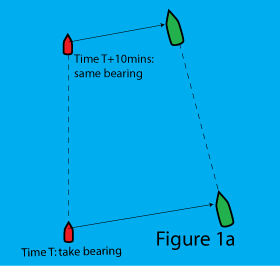
In practice when you see another vessel you can make a quick visual check, observing for example whether they are moving to right or left against the land in the distance beyond them, or whether they stay lined up on a particular part of your own boat (you have to keep a constant heading for the second method to work). But if you suspect hat you might be close to a collision course, the surest method is to observe the other vessel over a period of time with the hand-bearing compass. If the bearing doesn't change then a collision risk "is deemed to exist", and you then have to assess what you are required to do under the rules. 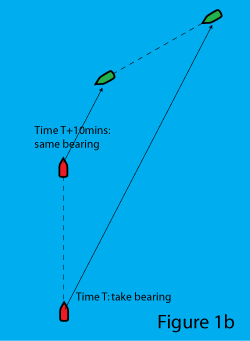
(If the bearing changes, you will be able to tell whether you are going to cross behind, or in front of, the other vessel.)
What to Do Next
In most situations where a collision risk exists, the rules define that one of the vessels "shall keep out of the way" of the other. In these cases the one that is obliged to keep out of the way is referred to as the give-way vessel. The other is referred to as the stand-on vessel. Both vessels have obligations under the rules.
Action by Give-Way Vessel (RULE 8, RULE 16)
If you are the give-way vessel, you need to alter your course and/or speed to keep out of the way of the other vessel. There are some additional considerations:
• the action you take must be taken early, to keep the risk of collision (or confusion) to a minimum
• the action needs to be positive and obvious, so the other vessel can see what you are doing (small changes will not be apparent to them)
• it also needs to be substantial, both to make it obvious, and also to keep a safe distance between the two vessels.
Clearly you need to consider any other vessels in the area and the safety of your own vessel (sea conditions, dangers) and all of this makes early, positive action sensible. If you leave it too late, you limit your options and may get dangerously close to a collision situation.
Normally you alter course to go behind the other vessel, which is obviously safer and gives you more control over the distance between the vessels.
Action by Stand-On Vessel (RULE 17)
If you are the stand-on vessel, and the other vessel has to keep out of your way, you might think you can relax, but it isn't quite that easy. For a start, you don't know if he has spotted the collision risk, or what he is going to do about it. You need to make it easy for him to avoid you, but ultimately it is still your responsibility to avoid the collision. For these reasons the rules specify what action you should take, and they are slightly more complex than the rules for giving way:
1. Hold your course and speed.
This is a requirement under the rule, and makes it easier for the other vessel to avoid you. (In an ideal world this is all you should have to do.)
2. You may take action to avoid collision if ...
If it becomes apparent that the other vessel is not taking the appropriate action for a give-way vessel under the rules. In other words, you don't have to hold on until there is a serious risk of collision; he should have taken early and substantial action under the rules, and you have the option to do something if he doesn't.
You have to be careful here, though. You might be in trouble if he simultaneously alters course to avoid you, so you need to take some action that will avoid the collision if that happens (e.g. tack, and head away from him). Think about this in advance and have your action planned.
3. You shall take action to avoid collision if ...
If collision cannot be avoided by the action of the other vessel alone. This is another requirement: ultimately it is both vessels' responsibility to avoid the collision.
Collision Risk Situations
Having decided whether a collision risk exists, and knowing what to do if you are the give-way or stand-on vessel, what we need to know now is: which vessel is the give-way and which the stand-on, in the various possible situations where a collsion risk exists.
Overtaking (RULE 13)
Any vessel overtaking another is required to keep out of the other's way until she is well clear. This applies even if you would 'normally' be the stand-on vessel, e.g. if you are sailing past a power-driven vessel. 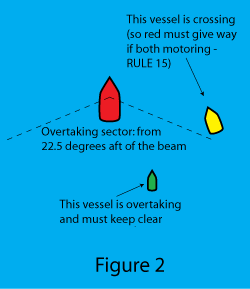
Overtaking is defined as coming up to another vessel from a direction as shown in Figure 2. In the diagram the green vessel is overtaking the red, but the yellow vessel is not.
Incidentally, this does not give the vessel being overtaken the right to turn in front of the overtaking vessel: it would be poor seamanship to do that. You need to check, before altering course, whether there is any other vessel overtaking you.
Two Sailing Vessels (RULE 12)
Two sailing vessels decide which one is the give-way vessel on the basis of which tack they are on. (Provided neither is motoring, in which case she is a power-driven vessel.)
A vessel on port tack (i.e. with the wind on the port side and sails set on the starboard side: the mainsail set to starboard if goose-wing) must give way to a vessel on the starboard tack. If both vessels are on the same tack, the windward vessel gives way.
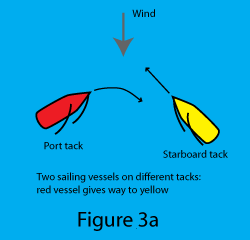
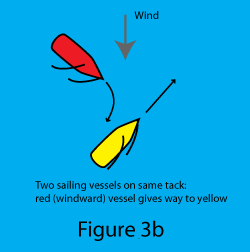
Figures 3a and 3b illustrate these situations.
Power-Driven Vessels: Head-On (RULE 14)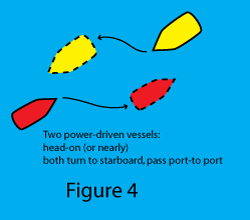
Two power-driven vessels approaching each other head-on (or very nearly head-on) should each alter course to starboard, and pass one another port-to-port. Figure 4 illustrates.
Note that this is consistent with the rule for narrow channels (see below).
Power-Driven Vessels: Crossing (RULE 15)
The more general case is when two power-driven vessels are crossing each other. In this case, the vessel which has the other on her starboard side must give way. Figure 5 illustrates this. 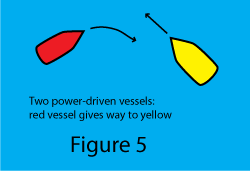
The rules effectively define three sectors around a vessel motoring (illustrated in Figure 6). If the other vessel is your the port sector, you are the stand-on vessel. If the other vessel is in your starboard sector, you are the give-way vessel.
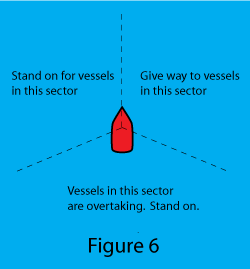 If the other vessel is approaching you in your astern sector, it is overtaking, so you stand on (and if you are approaching in his astern sector, you keep clear - see Overtaking, above).
If the other vessel is approaching you in your astern sector, it is overtaking, so you stand on (and if you are approaching in his astern sector, you keep clear - see Overtaking, above).
Remember: sailing yachts are power-driven vessels when they are motoring or motor-sailing.
Responsibilities Between Vessels of Different Types (RULE 18, RULE 3)
The rules establish a sort of 'pecking order' between different types of vessel when they are underway (i.e not moored, anchored or aground), according to their manoeuvrability. The types of vessel (defined in RULE 3) are:
a) power-driven vessel (any size, but not constrained by draught)
b) sailing vessel (not using her motor)
c) vessel engaged in fishing: this means actually fishing, not just a fishing boat going home for tea (although I wonder if some of them know that...)
d) vessel constrained by draught: this means severly restricted in the course she can follow because of the available depth of water
e) vessel restricted in her ability to manoeuvre: this means restricted by the nature of her work, which includes underwater operations, dredging, surveying, towing etc.
f) vessel not under command: this means unable to manoeuvre because of some exceptional circumstance, e.g. steering or engine failure.
As logic would suggest, each type of vessel in the list should keep out of the way of the ones beneath it. This is where the old adage "power gives way to sail" comes from, but you can see that there are four classes of power-driven vessel that do NOT give way to sail, and sailing yachts need to know this and give way to them.
This raises the logical question of how you know that a vessel is engaged in fishing, constrained by draught, restricted in her ability to manoeuvre or not under command. The answer is that they are obliged to show certain lights and shapes, and these are dealt with in the section below.
Narrow Channels (RULE 9) 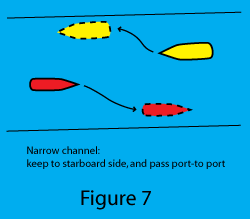
The main rule is "keep to the starboard side", passing on-coming traffic port-to-port.
See Figure 7. Small vessels and sailing vessels must not impede vessels that can only navigate within the channel.
For the yachtsman in practice, there are two types of "narrow channel": small channels that we need to follow because of our draught (which are probably not used by very large vessels) and ones that are defined for the purpose of large ships. In the former type, we keep as close as possible to the starboard side and exercise extreme care when overtaking. In the latter type we keep out of the way, and possibly out of the channel altogether if we can, particularly if it is busy.
Traffic Separation Schemes (RULE 10) 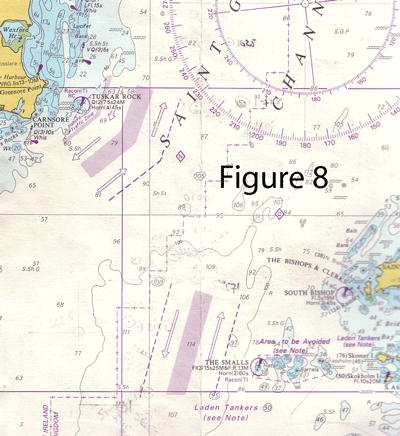
Traffic Separation Schemes are defined areas (marked on the chart - see Figure 8) where shipping traffic is directed to follow traffic lanes, which help to keep opposing traffic safely separated. They are relatively small areas in particularly busy spots (Dover Straits, Land's End), usually a few miles from the coast.
Small craft and yachts are advised to keep away from traffic separation schemes. If obliged to cross one, we should do so as nearly at right angles to the traffic flow as possible, and not impede the passage of vessels using the traffic lanes.
Restricted Visibility (RULE 19)
For obvious reasons, the above rules are for vessels in sight of one another and most of them would be extremely difficult to apply if you can't see the other vessel.
The main instruction in the rules is to reduce speed, and be ready to take immediate manoeuvres to avoid collision in a close quarters situation.
Boats with radar and trained operators will be using those, and their use is outside our current scope. The best advice to avoid being run down is:
• use a radar reflector
• keep a good lookout by sight and sound
• be ready to take immediate and drastic avoiding action
• keep clear of shipping channels, and if possible stay in shallow water.
Lights and Shapes
As stated in the introduction, as well as defining the Rules of the Road, the IRPCS define (in considerable technical detail) the lights that vessels are expected to display at night time and in poor visibility, and the day time shapes they are expected to show.
A number of the rules in the previous section relate to what a vessel is doing and what type of vessel it is. So vessels display that information for the benefit of others, by day and by night, so that other vessels can take the correct action.
Skippers have the responsibility of displaying the correct lights and shapes in different circumstances, and also of being able to interpret those of other vessels. The purpose of this section is to tell you about the different lights and their meanings. As ever, refer to the text of the IRPCS (see our recommendation in the Introduction) for definitive detail.
Visibility of Lights (RULE 22)
The IRPCS define the brightness of lights, according to the type of light and size of vessel, and you should refer to them if you are fitting lights to your vessel. The information is outside our scope here, because skippers will not normally need it.
Types of Light (RULE 21)
Most vessels require several different types of light, and the six types are described below (sailing yachts need to display the first four at various times, depending on what they are doing).
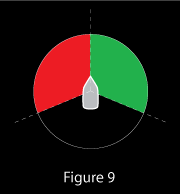
Sidelights
Sidelights are: a green light on the starboard side and a red light on port. Each light shines in a sector from dead ahead to 22.5 degrees aft of the beam.
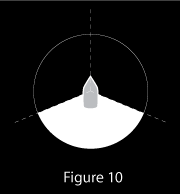
Sternlight
A sternlight is a white light at the stern of the vessel, shining astern, in a sector from 22.5 degrees aft of the beam on one side to the same angle on the other side. See Figure 10.
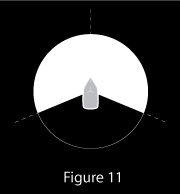
Masthead light
A masthead light is a white light which shines forward. It is generally situated high up on the vessel's mast. It can be seen in a sector from 22.5 degrees aft of the beam on one side to the same angle on the other side. (In other words, the exact opposite of the stern light.) See Figure 11.
This light is commonly known as a steaming light on yachts.
All round light
An all round light is a light that shines in a full circle round the vessel. It can be red, white or green depending on its application.
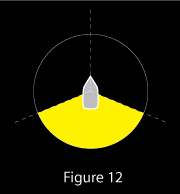 Towing light
Towing light
A towing light is a yellow light shining in the same sector as a sternlight. See Figure 12.
Flashing light
A flashing light is defined as a light flashing at a constant frequency of 120 or more per minute.
Lights that You Need to Display
As a skipper, you need to know what lights to display in the vessels you are likely to be in charge of.
Sailing vessel under 7m (RULE 25): none mandatory, but you need a white torch or lantern available to shine at other boats. (You can display the lights for a larger yacht if practicable.)
Power vessel under 7m, maximum speed less than 7 knots (RULE 23): all-round white light (you can display sidelights if practicable). Most people in small tenders with outboards regard themselves as exempt from this, but carry a torch.
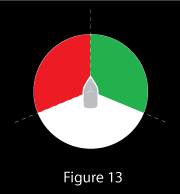
Sailing vessels underway (RULE 25): sidelights and sternlight - see Figure 13. Under 20m, these can be carried as a single "tri-colour" light at the top of the mast, which is a good idea because it takes less power and can be seen further away.
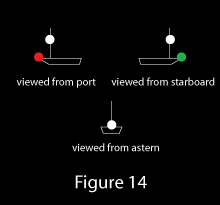 Power vessels underway (including sailing vessels when motoring) (RULE 23): sidelights, sternlight and masthead light. The masthead light (also known as a steaming light) needs to be placed higher than the sidelights. See Figure 14.
Power vessels underway (including sailing vessels when motoring) (RULE 23): sidelights, sternlight and masthead light. The masthead light (also known as a steaming light) needs to be placed higher than the sidelights. See Figure 14.
(If the vessel is less than 12m, it is allowed show a single all round white light instead of masthead and sternlights. Sidelights are still required.)
At anchor (RULE 30): none required if less than 7m, but otherwise an all round white light. In daytime, a ball.
Motoring with sails up in daytime (RULE 25): display a cone shape, with apex pointing down (at night, sidelights, sternlight and masthead light).
So if you are skippering a medium sized yacht, the lights you need are: sidelights and sternlight, and a white masthead light (steaming light) higher than those. You will also need an all round white anchor light. As an extra, you could carry a tri-colour at the top of the mast, which provides sidelights and sternlight for sailing, with only one bulb: drawing less power and giving longer range visibility than deck level lights.
You need to carry two shapes: an anchor ball and a motoring cone.
Lights that Other Vessels Will Display
When you are at sea you will see vessels' lights, and from that you need to deduce what kind of vessel you are seeing, and what it is doing.
Single White Light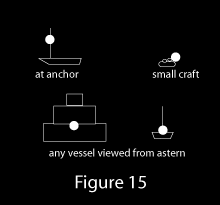
There are a number of possibilities that you need to be aware of, and you need to deduce what this is by taking other factors into consideration. It could be an anchor light (are you near an anchorage?) of a vessel less than 50m in length. It could be almost any vessel's sternlight (in which case, if you are getting closer to the light, you are probably overtaking them), or it could be a motor vessel less than 7m in length (more likely in sheltered waters close inshore; most vessels in the open sea would show sidelights).
See Figure 15. Note that if you are approaching any of these, you will have to keep out of their way.
Single Red or Green Light
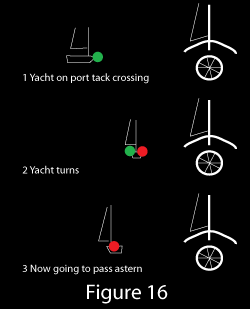 Normally a sailing vessel (RULE 25), and the light allows you to work out which side you are seeing and therefore roughly where it is heading (and perhaps which tack it is on).
Normally a sailing vessel (RULE 25), and the light allows you to work out which side you are seeing and therefore roughly where it is heading (and perhaps which tack it is on).
Incidentally, if you need to give way at night, the only way you can make it obvious to the other vessel that you have changed course is to make sure he can see your other sidelight.
See Figure 16. In this example, you can see another sailing yacht on your port bow, and the wind is on your starboard side. He is coming from the opposite direction, so he must be on port tack. This means he should give way. Initially you see his starboard sidelight, which means he is going to cross your track. Then when alters course to go behind you, you see his port sidelight and you know he has taken the required action.
Red or Green with White Masthead Light (Steaming Light)
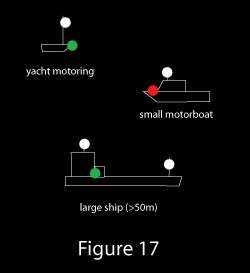 Power-driven vessel underway (RULE 23).
Power-driven vessel underway (RULE 23).
If there are two white masthead lights the vessel is over 50m in length, and the forward masthead light is lower than the aft one (both are higher than the sidelights). This makes it even easier to tell which side you are looking at.
Figure 17 shows examples.
Any one of those is simply a power-driven vessel, and is required to give way to a sailing vessel. If they have additional lights, they are telling us that they are one of the types of power-driven that sailing vessels have to give way to.
Other Lights and Shapes, and Their Meanings:
Vessel Engaged in Fishing (RULE 26) 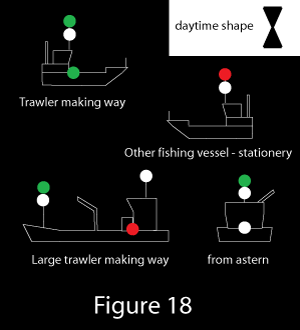
Vessels engaged in fishing exhibit two all round lights as follows: if trawling, green over white. If fishing other than trawling, red over white.
If they are making way through the water they also display sidelights and a sternlight, and if over 50m a higher masthead light further aft: just like normal power-driven vessels.
Figure 17 shows examples. The two all round lights take the place of the steaming light when they are making way through the water. In the daytime they show two cones one above the other, with their apexes pointing towards each other.
If the vessel has gear extending more than 150m from it, it will show an additional all round white light, or by day a cone pointing upwards, in the direction of the gear.
Vessel Not Under Command (RULE 27) 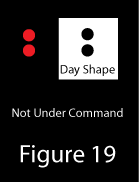
Like a fishing vessel, a vessel not under command (for a definition see previous section or RULE 3) is required to display two all-round lights is a vertical line: this time two red lights.
When making way through the water they also show sidelights and a sternlight.
The daytime shapes are: two balls in vertical line. See Figure 19.
Vessel Restricted in Ability to Manoeuvre (RULE 27) 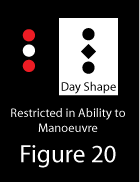
Vessel restricted in ability to manoeuvre show three all round lights in vertical line: red - white - red.
The daytime shapes are: ball - diamond - ball in vertical line. See Figure 20.
When making way through the water they also show the lights required for a power-driven vessel making way; similarly when anchored, they show the normal anchor lights described below, (in addition to the red white red all round lights).
Dredging / Underwater Operations - with Obstruction on One Side (RULE 27)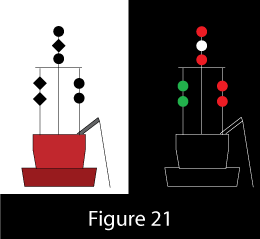
Sometimes a vessel restricted in ability to manoeuvre needs to tell other craft about an obstruction on one side and indicate that they should pass on the other. An example might be dredging in a narrow channel.
The obstructed side is indicated by two all round red lights or two balls in daytime; the clear side shows two all round green lights or two diamonds. See Figure 21.
Vessels Constrained by Their Draught (RULE 28) 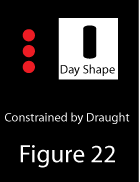
Vessels constrained by their draught show three all round red lights in vertical line, in addition to all the usual lights for a power-driven vessel underway.
The daytime shape is a cylinder. See Figure 22.
Divers (RULE 27)
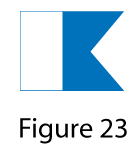 Some professional diving will take place from commercial vessels showing the lights and shapes for restricted in ability to manoeuvre and perhaps also for underwater operations on one side of the vessel, in which case you would be keeping clear anyway.
Some professional diving will take place from commercial vessels showing the lights and shapes for restricted in ability to manoeuvre and perhaps also for underwater operations on one side of the vessel, in which case you would be keeping clear anyway.
However, amateur diving from small vessels is very much more common. Look out for RIBs or small inflatables, or perhaps a medium sized motor boat, which could be some way off the shore and right in your path along the coast. They will be flying the A flag which means "I have a diver down: keep well clear" - or showing a rigid replica of it. See Figure 23.
Pilot Vessels (RULE 29)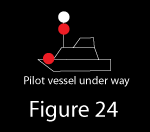
Because they need to approach and manoeuvre up to larger vessels, pilot vessels need to be readily identified at night. Their lights, when engaged on pilot duty, are: two all round lights, white over red. See Figure 24.
In addition they show sidelights and sternlight when underway, and normal anchor lights when at anchor.
If you are getting confused between pilot boats and fishing boats, try this one:
"White over red, Pilot in bed: red over white, frying tonight".
Towing and Pushing (RULE 24)
This gets a bit complicated, not least because there are so ways to go about towing or pushing, and a variety of objects of differing sizes that may be manoeuvred in that way. Broadly, however, you probably don't need to remember every part of the rule in order to recognise that towing is happening, and to keep out of its way.
The simplest part of the rule is if a pushing vessel and vessel being pushed are rigidly connected, they are (quite sensibly) regarded as one power driven vessel and lit accordingly.
The Vessel Towing (or Pushing)
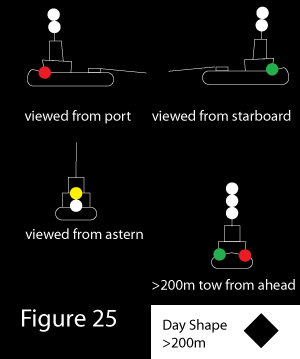 Next a "normal" tow, with towing vessel in front pulling with a rope. The towing vessel is like a normal power driven vessel but with two white masthead lights instead of one. The masthead lights are placed in a vertical line.
Next a "normal" tow, with towing vessel in front pulling with a rope. The towing vessel is like a normal power driven vessel but with two white masthead lights instead of one. The masthead lights are placed in a vertical line.
If the length of the tow exceeds 200m from the sterm of the towing vessel, three white masthead lights; and also in this case, a diamond shape by day (there is also one of these on the towed vessel or object).
It also shows a yellow towing light in vertical line above the sternlight. See Figure 25.
Not shown on the figure: if the towing vessel is more than 50m long, like any other power-driven vessel it must show a second masthead light, higher and further aft.
A vessel pushing, or towing alongside, has the two masthead lights, but no yellow towing light (this is logical, because it clearly doesn't have the same danger astern of it).
The Vessel (or Object) Being Towed (or Pushed) 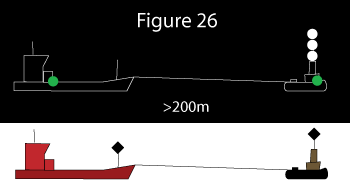
This also needs to be lit.
If it is a vessel, towed behind or alongside, it shows sidelights and a sternlight. If it is being pushed ahead, just sidelights. If the length of the tow is more than 200m, the towed object displays a diamond, as does the object being towed. See Figure 26.
An object, or partially submerged vessel, will be lit by one or more all round white lights depending on the size. By day a diamond shape at the back and, if over 200m, at the front as well.
What if You Are Towing Something?
Professional organisers of tows should definitely not take this source as guidance, but should seek the exact text of the IRPCS! However, what do you do if, as skipper, you are obliged to tow something like another vessel behind your yacht, e.g. to rescue it?
The answer is that, if possible, you light the tow rope to show that the two vessels are connected.
Anchoring (RULE 30) 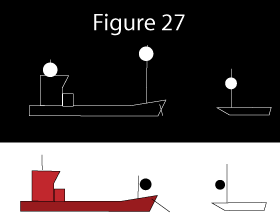
Vessels less than 50m (and greater than 7m) need a single all round white light. Vessels more than 50m need two all round white lights, one forward and the second one lower down, aft. Very large vessels are also encouraged to turn on decklights. The day shape is a ball. See Figure 27.
If in addition you see: two all round red lights, or three balls, in vertical line, this means the vessel is aground (not required in vessels less than 12m).
Sound and Light Signals
This section is about signalling between vessels. This is done mainly with sounds, and sometimes lights are also used to back up the sound signals. You will find the full 'chapter and verse' in Section D of the IRPCS, entitled Sound and Light Signals.
The Regulations include specifications of the equipment to be used, which we will not elaborate here.
As with the lights, the important thing as a skipper is to:
a) know what sounds you are expected to make and the right equipment to carry on board
b) recognise the signals that other vessels are making for your benefit.
Most yachts carry aerosol signalling horns if they do not have an electric horn installed, plus a bright torch or spotlight.
There are two categories where specific signals are defined: Manoeuvring and Warning Signals, and Restricted Visibility (Fog) Signals.
There are also Signals to Attract Attention (RULE 36), but these are simply any sound or light signal that cannot be mistaken for the other categories. If someone sets off a white flare, or shines a spotlight at you, they are trying to attract your attention. Similarly you can do these things (or shine a light on your sail) if you think another vessel hasn't seen you.
Manoeuvring and Warning Signals (RULE 34)
The first four signals are important to learn, because they are used by large vessels to tell us what they are doing - so doing the correct thing in response depends on immediately understanding what they are telling you.
"Short blast" means about a second, and these can be reinforced by light signals.
One short blast: I am altering my course to starboard
Two short blasts: I am altering my course to port
Three short blasts: I am operating astern propulsion (i.e. slowing down, stopping and/or going in reverse)
Five short blasts: I am unsure of your intention, or I am unsure you are taking sufficient action to avoid collision: diplomatic language for Get Out Of The Way.
There is another group of signals that you are less likely to hear, or have to react to. They concern one vessel intending to overtake another in a narrow channel.
Two long blasts and one short blast: I intend to overtake you on your starboard side
Two long blasts and two short blasts: I intend to overtake you on your port side
The vessel being overtaken can signal her agreement with: one long, one short, one long, one short.
(This is morse code "C - Charlie", meaning "OK" - easily remembered because it sounds like "Charlie Charlie")
The final sound in this section is one prolonged blast (four to six seconds) which is used by vessels in narrow channels coming up to a bend or obstruction. It is answered by the same signal from another vessel coming the other way.
Sound Signals in Restricted Visibility (RULE 35)
There is a list of these, reflecting the need to identify to other vessels what kind of vessel you are. Most of them are repeated every two minutes or so.
One prolonged blast: power-driven vessel making way
Two prolonged blasts: power-driven vessel stopped (but not anchored)
One prolonged and two short blasts: not under command, restricted in ability to manoeuvre (including when anchored), constrained by draught, sailing vessel, engaged in fishing (including when anchored), engaged in towing or pushing. In other words, everything that a power-driven vessel has to give way to.
One prolonged and three short blasts: the vessel being towed. Ideally this signal is made immediately after the towing vessel's signal.
Bell (rapid ringing for five seconds - at one minute intervals): vessel at anchor. Vessels aground also sound three distinct strikes of the bell immediately before and after the rapid ringing.
Bell plus Gong (for five seconds): a vessel over 100m in length at anchor sounds the bell in the forepart of the vessel, then immediately sounds the gong in the after part.
One short, one prolonged and one short blasts: vessel at anchor to warn an approaching vessel.
Four short blasts: pilot vessel engaged on pilotage duty.
Skippers need to know what sounds they are required to make. When underway, a motor boat (or yacht motoring) gives a prolonged blast every two minutes. When sailing, one long and two short.
Vessels less than 12m are not obliged to make these signals but should make some other sound every two minutes.
At anchor, vessels less than 20m are not obliged to give the bell signal but should make some other sound every two minutes. 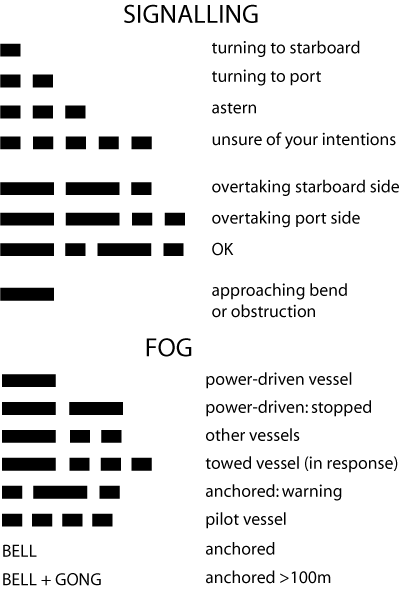
Learn the first four!
Distress Signals
It is the International Regulations for Prevention of Collision at Sea that give the full definitive list of distress signals, in Annex IV. So here they are.
It will be evident that some are more useful and usual than others, and the 'recommended' ones are highlighted in bold. But ANY of these is a distress signal which skippers should be able to recognise:
(a) a gun or other explosive signal fired at intervals of about one minute
(b) continuous sounding with any fog signalling apparatus
(c) rockets or shells throwing red stars, fired one at a time at short intervals
Similar to what we carry in standard flare packs, or Very pistols.
(d) a signal made with any signalling method consisting of the group S O S in the Morse Code: • • • - - - • • •
Very widely recognised and easily produced with a torch, horn etc.
(e) a signal sent by radiotelephony consisting of the spoken word "Mayday"
Usually the best method, because you can then have a conversation with the Coastguard on the VHF. See below.
(f) the internal code signal of distress indicated by N C
(g) a signal consisting of a square flag having above or below it a ball or anything resembling a ball
(h) flames on the vessel
(i) a rocket parachute flare or hand flare showing a red light
Both are carried in standard flare packs.
(j) a smoke signal giving off orange coloured smoke
Also in flare packs, for daytime use.
(k) slowly and repeatedly raising and lowering arms outstretched to each side
(l) the radiotelegraph alarm signal
(m) the radiotelephone alarm signal
(n) signals transmitted by emergency position-indicating radio beacons (EPIRBs)
Very useful if you carry one - the only effective signal when a long distance from shore.
(o) approved signals transmitted by radio communication systems, including survival craft radar transponders
SART devices are also very useful, because they give considerable assistance in rescue scenarios.
Mayday Message
The Mayday call is by far the most useful method of signallling distress and getting rescued. (Why "Mayday"? Because it's from the French for "Help me" - "M'Aidez". Most of the radio procedural words are anglicised French.) This is outside the scope of the IRPCS, but it is logical to tell you about it here.
There is a specified set of information that you should provide in a Mayday message, in a particular order. Don't worry if you can't remember it exactly, but this is the "proper" form of a Mayday message and the Coastguard will ask you for this information if you don't include it. (<identity> is the name of the vessel):
"Mayday Mayday Mayday"
"This is <identity> <identity> <identity>"
"Mayday"
"<identity>"
"My position is ... " (either Lat and Long, or distance and direction from a known point)
Nature of distress: e.g. "We are taking on water ...."
Assistance required: e.g. "We require immediate assistance."
"The number of people on board is ... " (include everyone)
Any other helpful information: e.g. "We are a small blue-hulled yacht and we are firing distress flares"
"Over"
My personal mnemonic for the above is M I P D A N I O - for Mayday Identity Position Distress Assistance Number Information Over - which for some reason is strangely memorably.